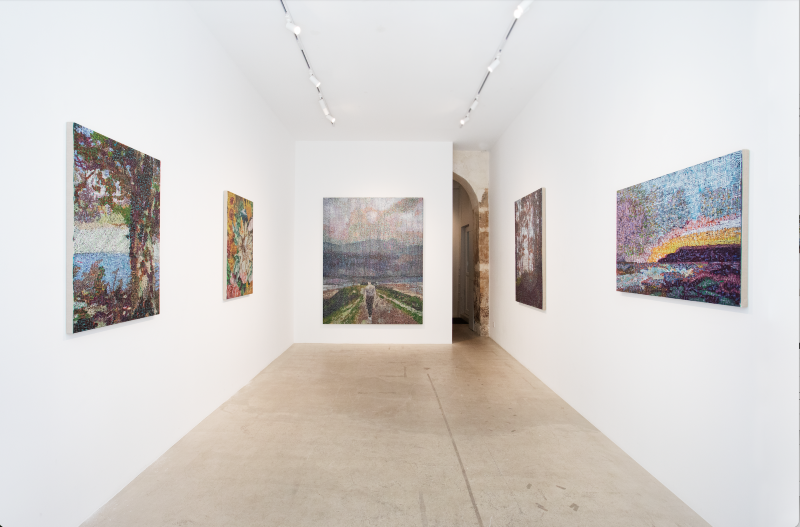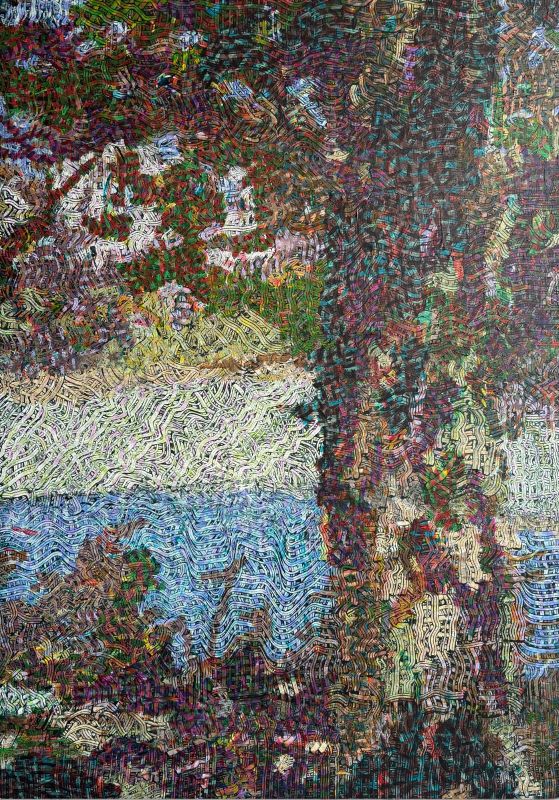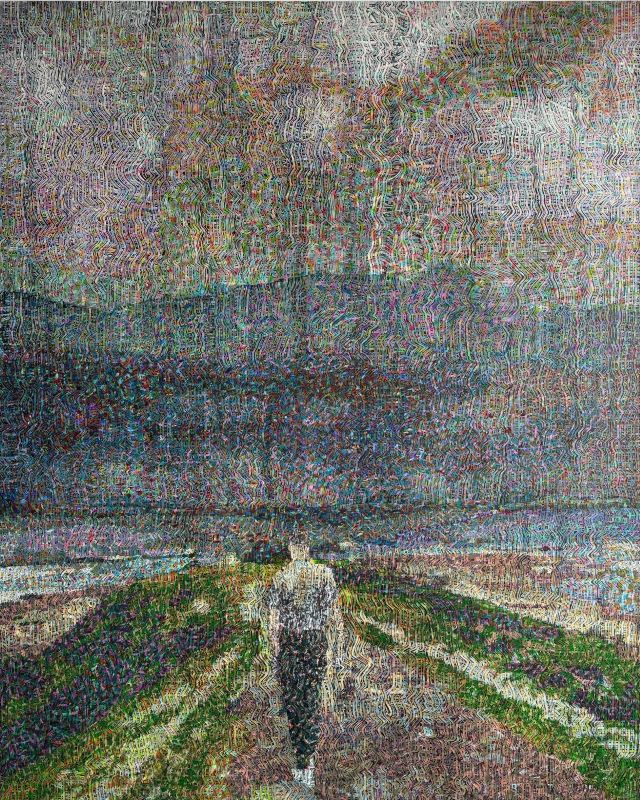Afterlight - Gregory Hodge
The exhibition
Gregory Hodge is an important Australian artist on the contemporary scene. Recently based in Paris, his solo exhibition Afterlight at Galerie Anne-Laure Buffard has been shown in the UK, Singapore, the USA, Hong Kong, Belgium and Australia. With a degree in Fine Art and a doctorate in Aesthetic Philosophy, Buffard's practice revisits the technique of the Nabis, focusing on the question of memory.
Inspired by Australian landscapes, tapestries from the Manufacture des Gobelins and the Nabi movement - which included Gauguin, Vuillard and Bonnard - Gregory Hodge's works are rich in detail and impression. Almost trompe-l'œil, his large-scale canvases play on figuration and abstraction, recreating spaces, interior scenes and bouquets of flowers using a particular technique. He combines acrylic paint with translucent pigmented gels for a glossy, nuanced finish, then makes his own convoluted brushes for the textile illusion. Indeed, the artist appears to be imitating the making of a tapestry, with its multitude of intertwined curved lines. With this approach, Hodge deliberately alters the legibility of his image, painted from his photographs, in order to question our way of seeing.
"Afterlight" - the title chosen for the exhibition - refers to one of the artist's works, which depicts a forest whose dark colours indicate that it was painted against the light. The magic of Gregory Hodge's work lies in the windows of light that make up each of his canvases. Like a photographer, he captures sources of light, whether light or dark. Through different prisms and points of view, the artist gives viewers a glimpse of his landscapes, which reveal themselves to our gaze as we move away from them. This interplay between distance and proximity allows us to rediscover the canvas over and over again. "Seascape" (2025) is a perfect example of the distortion of the image, offering visitors a contemplative and meditative moment of grandiose nature in motion and a frozen moment, blurred by his painting technique. His works therefore seem to appeal to the memory and nostalgia of a past life: ‘Gregory Hodge paints with what he remembers’ (Henri Guette). (Henri Guette) This feeling is reinforced by the predominance of dark, cold colours, and by the repetitive regularity of the pictorial movement made up of curves and undulations. The artist's aim is not to veil the subject or hide his gestures, but to make each of the layers visible on the canvas in order to bring consistency and living matter to his composition. "Lake" (2025) reflects the different stages in the making of the work, with the meticulous superimposition of elements. The first layer sets the scene for a lake; the second layer adds subtlety and complexity with the tree in ultraviolet colours; and finally the striations renew the use of acrylic paint. Gregory Hodge offers a contemporary vision of the Post-Impressionist movement to which he belongs.
For this exhibition, the artist returns to figurative painting, partially abandoning abstraction in favour of a transcription of reality. By blurring his images in the manner of digital defects, he introduces a visual disturbance that engages with memory: the saturated image becomes a motif that is both aesthetic and meaningful. Through this precise weaving, he creates a body of work in which memory, emotion and the pictorial gesture combine to restore the intimate perception of a moment altered by time.
Agathe Fumey
Inspired by Australian landscapes, tapestries from the Manufacture des Gobelins and the Nabi movement - which included Gauguin, Vuillard and Bonnard - Gregory Hodge's works are rich in detail and impression. Almost trompe-l'œil, his large-scale canvases play on figuration and abstraction, recreating spaces, interior scenes and bouquets of flowers using a particular technique. He combines acrylic paint with translucent pigmented gels for a glossy, nuanced finish, then makes his own convoluted brushes for the textile illusion. Indeed, the artist appears to be imitating the making of a tapestry, with its multitude of intertwined curved lines. With this approach, Hodge deliberately alters the legibility of his image, painted from his photographs, in order to question our way of seeing.
"Afterlight" - the title chosen for the exhibition - refers to one of the artist's works, which depicts a forest whose dark colours indicate that it was painted against the light. The magic of Gregory Hodge's work lies in the windows of light that make up each of his canvases. Like a photographer, he captures sources of light, whether light or dark. Through different prisms and points of view, the artist gives viewers a glimpse of his landscapes, which reveal themselves to our gaze as we move away from them. This interplay between distance and proximity allows us to rediscover the canvas over and over again. "Seascape" (2025) is a perfect example of the distortion of the image, offering visitors a contemplative and meditative moment of grandiose nature in motion and a frozen moment, blurred by his painting technique. His works therefore seem to appeal to the memory and nostalgia of a past life: ‘Gregory Hodge paints with what he remembers’ (Henri Guette). (Henri Guette) This feeling is reinforced by the predominance of dark, cold colours, and by the repetitive regularity of the pictorial movement made up of curves and undulations. The artist's aim is not to veil the subject or hide his gestures, but to make each of the layers visible on the canvas in order to bring consistency and living matter to his composition. "Lake" (2025) reflects the different stages in the making of the work, with the meticulous superimposition of elements. The first layer sets the scene for a lake; the second layer adds subtlety and complexity with the tree in ultraviolet colours; and finally the striations renew the use of acrylic paint. Gregory Hodge offers a contemporary vision of the Post-Impressionist movement to which he belongs.
For this exhibition, the artist returns to figurative painting, partially abandoning abstraction in favour of a transcription of reality. By blurring his images in the manner of digital defects, he introduces a visual disturbance that engages with memory: the saturated image becomes a motif that is both aesthetic and meaningful. Through this precise weaving, he creates a body of work in which memory, emotion and the pictorial gesture combine to restore the intimate perception of a moment altered by time.
Agathe Fumey
When
06/05/2025 - 19/06/2025


